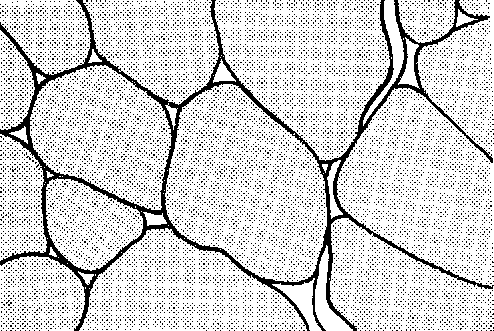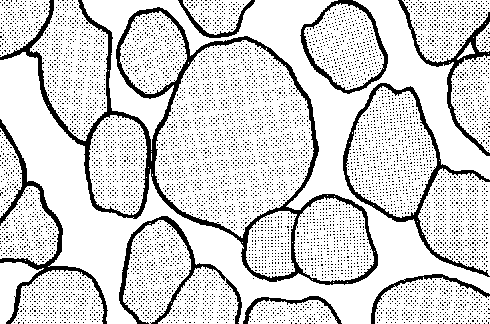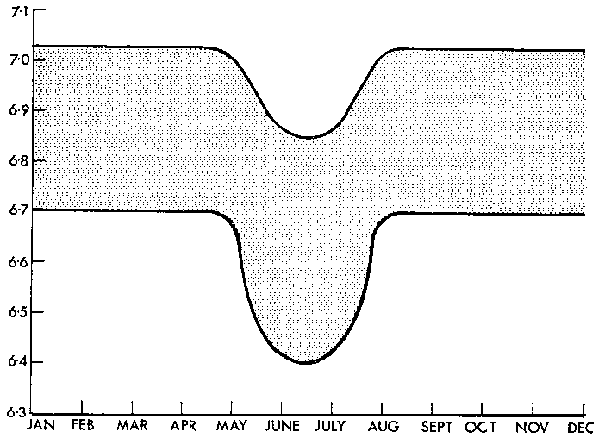Introduction
Appearance
Condition and the spawning cycle
Feeding after spawning
What to look for
Conclusions
This note discusses seasonal variation in the initial quality of cod from different fishing grounds, and how this can affect their suitability for chilling, freezing and subsequent processing.
Cod is the most important commercial species of fish in Britain. Buyers at port auctions can often tell where a cod has been caught by its shape, colour or smell, and may prefer the catch from certain grounds at a particular time of year when there is a choice. It is also common experience that cod does not keep so well in ice at certain seasons, or does not yield as satisfactory a frozen or smoked product. This note summarizes what is known about the effects of ground and season, so that the catcher and processor can recognize the signs that indicate suitability for processing.
Colour
The colour of cod usually corresponds with the colour of the ground on which it was caught. Iceland cod are generally dark in colour; Icelandic grounds are often covered with dark volcanic debris. Faroe cod, taken off a light brown shell bottom, are light in colour, and Faroe Bank cod, taken off a white shell bottom, are lighter still; other species, for example haddock, lemon sole and halibut, are also light in colour when taken on Faroe Bank. Cod from coastal waters off Norway and the west of Scotland are reddish or bronze coloured; the red is thought to derive from a background of red seaweed, but a diet of shrimp has also been known to redden the skin. The colour changes after death and, where fish have been stowed together, the parts in contact with other fish become lighter, giving a patchy appearance when separated. The effect wears off after a day or two in iced storage, so that patchiness is usually seen on the market only on inshore fish.
Shape
Cod from certain grounds are much deeper in shape than from others; the plump Faroe Bank cod and the lean Bear Island cod probably represent the extremes in the north east Atlantic. These differences are probably caused by the amount of food available. The abundance of food on Faroe Bank results in cod that not only look plumper but also grow faster than elsewhere in the north east Atlantic. Plump fish giving a high fillet yield are usually well fed, but well fed cod have some disadvantages in processing, and these are described later.
Size
Both size and seasonal condition influence initial quality arid the effects are to some extent indistinguishable. Assuming for the moment that the cod in a batch are all in the same condition, then fillets from large fish will gape less than fillets from small ones. Gaping is discussed more fully in Advisory Note 61. Moreover, large cod are slightly tougher to eat after cooking than small ones, mainly because the flesh tends to be more acid.
Figure 1. Outline of a Bear Island cod set against the silhouette of a cod from Faroe Bank, drawn from photographs; notice the much deeper body of the Faroe Bank cod.

Large cod become more watery at spawning time because they draw more heavily on their body reserves to make eggs or sperm than do smaller fish spawning for the first time. They are therefore softer than small cod during and just after spawning, but they arc firmer during the rest of the year. Large cod frozen at sea at around spawning time are often less suitable for freezing, because of greater amounts of drip on thawing, and they are less suitable than small fish for freezing during the rest of the year because of their tougher texture. Thus although large cod tend to gape less than smaller ones, in general they are less suitable for freezing at sea; on the other hand they nearly always keep better in ice during summer and autumn.
Condition
Cod in good condition are lively when they are landed on the deck of the fishing vessel; they jump about in the pound, and their bodies are firm and resilient. The skinned fillets are bluish and translucent, and feel dry and springy to the touch. The fish look superb, and keep well in ice.
Cod in poor condition lie lifeless on the deck, and their bodies feel like putty when poked. The fillets are an opaque white, and feel wet to the touch, especially after a few hours. Cod in poor condition do not keep so well in ice, but may be suitable for freezing at sea.
The spawning cycle
Differences in condition are related to the spawning cycle. The sex organs in the cod are small during the summer and it is often difficult to find them in male fish. The organs start to grow rapidly about October in readiness for spawning in the spring. The fish are still feeding to some extent, but more and more of what they eat is being diverted to the sex organs instead of supplying energy for swimming or increasing the reserves in the liver. As winter progresses, the demands of the sex organs increase and the food supply diminishes. The fish have no choice but to break down some of the components of their own bodies to maintain the flow of materials to the sex organs. Proteins are drawn from all parts of the flesh; the hair-like cells of which the fish muscle is made then shrink, and the spaces between them increase and fill with fluid; this is why the flesh feels wet to the touch. After spawning the flesh becomes softer still, because food is still scarce. Only when the growth of surface plankton and the organisms that feed on it has increased in early summer can the cod obtain enough food to repair the damage. North Sea cod are not usually completely restored until late July.
Figure 2. Cross section through the muscle of a well nourished cod, highly magnified. The irregular looking areas are sections through the threadlike muscle cells, which touch around most of their borders. A fillet from this fish feels dry and firm to the touch.

Figure 3. Cross section through the muscle of a cod in poor condition after spawning, highly magnified. The cells have shrunk, and there are extensive spaces between them, filled with fluid. A fillet from this fish feels soft and wet to the touch, especially a few hours after death.

Cod spawn progressively later the further north they are found. They generally spawn at the beginning of March in the North Sea, at the beginning of April at Faroe, and nearly into May off Iceland. Thus soft fish in poor condition are found later and later in the year on more northerly grounds.
Cod spawn for the first time when they are about 70 cm long, wherever they are found. Each year afterwards, the sex organs at maturity occupy an increasing proportion of the body cavity. This means that in general the more mature a cod is, the more depleted it becomes at spawning time. Immature cod may scarcely change at all in the spring, when larger ones become lean and soft, and so will keep better in ice.
When a fish swims, the energy comes from glycogen, a form of glucose, stored in the muscle. When this is used up, more is transported from the liver by the blood to take its place, and the store in the liver is replenished from the food eaten by the fish.
When a fish dies after capture, the glucose material is broken down during the first 24 hours to lactic acid, thus making the fish muscle slightly acid. Acidity can be measured by an instrument, and the value is generally expressed as pH; the lower the pH the more acid there is present. The pH of cod is an important factor to the processor; cod with a high pH, that is with little lactic acid present, are soft and watery, and can have a shelf life of only 9 days in ice, compared with 14 days when the pH is lower. Fish with a fairly high pH, but not so high that the fish are watery, can be frozen at sea satisfactorily, since the soft texture will become firmer in cold storage, and there will be little tendency to gape.
Fish with a low pH keep well in ice, but when frozen at sea the flesh becomes unacceptably tough in cold store sooner, and fillets from the thawed whole fish are likely to gape badly; in extreme cases the fillets cannot be skinned without breaking up. The degree of acidity of cod flesh is dependent on the nutritional state of the fish. A starving cod has little glycogen in the muscle; hardly any lactic acid is formed when it dies and the pH is high. The pH remains high after spawning, while the cod is feeding only lightly, but towards the end of May in the North Sea it begins to gorge itself and the pH falls rapidly. The pH remains low for about a month, and then begins to rise again, perhaps because the cod adjusts to the mass of food, and deposits less glycogen in the muscle. On the other hand, the rise may reflect a change in diet; at the beginning of the heavy feeding, the cod crams in anything it can find, for example sand eels and herring larvae, but when the urge to eat is less frantic the cod seems more selective and feeds on shrimps, crabs and other shellfish. Whatever the reason the pH stays low for only a short time, fortunately for the processor.
For most of the year the pH of cod flesh is high enough to ensure a texture suitable for freezing at sea with little subsequent gaping. During the short period of heavy feeding and low pH the flesh of the still spent cod is too firm for freezing, the fillets will gape badly, and the flesh will be white, opaque and watery. It is generally thought that the heavy feeding causes the soggy white flesh, but this is not so; the cod have simply not been eating long enough to recover their dry, elastic condition.
Figure 4. Average pH values of groups of cod taken from grounds all over the north Atlantic at different times of year. Fish with a pH below about 6-6 are too tough for freezing, and gape after thawing and filleting.

Soft flesh, indicating starvation, is easily recognized. Further signs of starvation are a small red or mottled liver and a big blue or green gall bladder; the gall bladder is a pouch of fluid in or near the liver. If the liver and the gall bladder are both small, the cod has started to eat again but has not yet fully recovered. In a well fed, fully recovered cod the liver is large and creamy and the gall bladder is small and pale brown in colour.
Cod from different grounds are of different colours; colour, unimportant in processing, serves as a guide to the origin of the fish. Cod from different grounds are of different shapes; shape is important because it reflects the general nutritional state and fillet yield. Sudden heavy feeding, as revealed by the acidity of the flesh, is the most important single factor that affects (he suitability of cod for icing or freezing.
Cod with small reddish livers, large blue gall bladders and soft flesh spoil more rapidly than usual in ice, but attain a firmer texture in cold store when frozen at sea, provided the flesh is not so soft that the fillets are watery. In a batch of soft cod, large fish are more likely to be watery than small ones.
Cod with large creamy livers, small pale gall bladders and firm flesh keep well in ice, but when frozen at sea may yield tougher fillets that gape badly after thawing and filleting.
Differences between cod caught on different grounds at the same time of year are generally attributable to a difference in the spawning date, and in the amount of food available.
Above all, cod are least suitable for chilling or freezing during the period of heavy feeding following the return of normal food supplies. The flesh is opaque, gapes badly, and is tough, especially after cold storage. If you have any enquiries, write, phone or call at either of the addresses given below:
|
The Director |
The Officer in Charge |
|
Torry Research Station |
Humber Laboratory |
|
PO Box 31 |
Wassand Street |
|
135 Abbey Road |
Hull |
|
Aberdeeen |
HU34AR |
|
AB9 8DG |
|
|
Tel: 0224 877071 |
Tel: 0482 27879 |
61 GAPING OF FILLETS, BY R. M. LOVE.
62. The freezing time of fish, by F. J. NICHOLOSON.
63. Fishing ports in the UK, by J.J. WATERMAN.
64 Fish silage, by I. TATTERSON and M. L. WINDSOR.
65 Fishworking machinery, by S. MAIR.
66 Handling and processing mackerel, by J. N. KEAY.
67 The haddock, by J. J. WATERMAN.
68 Icemaking plant, by J. GRAHAM.
69 Cook-freeze fish products, by J. N. KEAY.
70 Advice for the fish industry; who does what, by J. J.
WATERMAN.
Earlier notes in the series, most of which are still available, are summarized in 60 Key to Advisory Notes 1-59, by J. J. WATERMAN.
Crown Copyright Reserved
Printed in Scotland by Her Majesty's Stationery Office at HMSO
Press, Edinburgh Dd 349079 10,000 11/76 (13717)